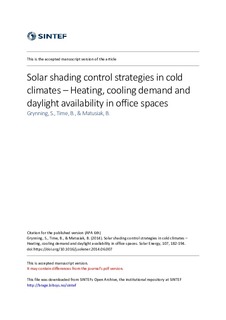| dc.contributor.author | Grynning, Steinar | |
| dc.contributor.author | Time, Berit | |
| dc.contributor.author | Matusiak, Barbara Szybinska | |
| dc.date.accessioned | 2018-02-20T13:39:03Z | |
| dc.date.available | 2018-02-20T13:39:03Z | |
| dc.date.created | 2014-07-26T16:27:16Z | |
| dc.date.issued | 2014 | |
| dc.identifier.citation | Solar Energy. 2014, 107 182-194. | nb_NO |
| dc.identifier.issn | 0038-092X | |
| dc.identifier.uri | http://hdl.handle.net/11250/2486028 | |
| dc.description.abstract | Modern office buildings often have large glazed areas. Incident solar radiation can lead to large cooling demands during hot periods although the solar radiation can help reduce heating demands during cool periods.
Previous studies have shown that large parts of the net energy demand of an office building is related to window heat loss and cooling demands induced by solar irradiance. In this article, the authors found that, even in what traditionally has been considered to be a heating-dominated climate, cooling demands dominate the net energy demand of an office building. Solar shading systems are vital to reduce the cooling demand of an office building.
Introducing shading systems might contribute to higher heating demands as well as higher demands for artificial lighting but at the same time it might be necessary in order to reduce glare issues.
Simulations of a number of shading strategies have been performed for south- and north-facing office cubicles with varying floor areas, window sizes and window parameters. Energy demands for heating, cooling, lighting and ventilation fans have been assessed. The simulations show that the choice of shading strategy can have an impact on the energy demand of the offices. Depending on strategy, the energy demand can either increase or decrease compared to an unshaded one- or two-person office cubicle.
In addition, the shading systems can contribute toward a lowered thermal transmittance value (U-value) of the window by functioning as an additional layer in the glazing unit when closed. Potential improvements of U-values have been studied in combination with the shading system’s effect on solar heat gains and daylight levels. Experimental investigations of in-between the panes solar shading system effects on window U-values are currently being carried out at the Research Centre on Zero Emission Buildings (www.ZEB.no).
It was found that automatically controlled shading systems can reduce the energy demands of south-facing, small office cubicles, but that they should not be installed without a thorough case-by-case investigation as increased energy demands were found if an improper shading strategy was chosen. Upgrading to four-pane glazing will, however, always have a beneficial impact on the energy demand compared to two- and three-pane glazing. | nb_NO |
| dc.language.iso | eng | nb_NO |
| dc.publisher | Elsevier | nb_NO |
| dc.rights | Attribution-NonCommercial-NoDerivatives 4.0 Internasjonal | * |
| dc.rights.uri | http://creativecommons.org/licenses/by-nc-nd/4.0/deed.no | * |
| dc.title | Solar shading control strategies in cold climates - Heating, cooling demand and daylight availability in office spaces | nb_NO |
| dc.type | Journal article | nb_NO |
| dc.type | Peer reviewed | nb_NO |
| dc.description.version | acceptedVersion | nb_NO |
| dc.source.pagenumber | 182-194 | nb_NO |
| dc.source.volume | 107 | nb_NO |
| dc.source.journal | Solar Energy | nb_NO |
| dc.identifier.doi | 10.1016/j.solener.2014.06.007 | |
| dc.identifier.cristin | 1144392 | |
| dc.relation.project | Norges forskningsråd: 193830 | nb_NO |
| dc.description.localcode | © 2014. This is the authors’ accepted and refereed manuscript to the article. This manuscript version is made available under the CC-BY-NC-ND 4.0 license http://creativecommons.org/licenses/by-nc-nd/4.0/ | nb_NO |
| cristin.unitcode | 194,61,55,0 | |
| cristin.unitname | Institutt for arkitektur og teknologi | |
| cristin.ispublished | true | |
| cristin.fulltext | original | |
| cristin.fulltext | postprint | |
| cristin.qualitycode | 2 | |

